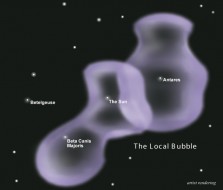I say that because Harvard is involved, and if you doubt who runs Harvard, just remember where Obama went to law school, and had a history there that no one can verify from school records, since they won't release them. Just a cautionary warning, and something to keep in the back of your mind, if they start blaming anything on that hot bubble.
X-Ray Glow Evidence of A Local Hot Bubble
http://www.skyandtelescope.com/astronomy-news/local-hot-bubble-07282014/
By: Maria Temming | July 28, 2014
Scientists have confirmed that the soft X-ray glow permeating the sky has two sources: one inside the solar system, one outside.
For over a decade, astronomers have debated the source of a soft X-ray glow that permeates the sky. Some thought the solar wind might be responsible, while others suspected an enormous bubble of hot gas. But a recent study published in Nature might finally settle the dispute: both sources are required to produce the X-ray background.
This X-ray background is an unexpectedly intense glow of soft X-rays blanketing the sky. X-rays at these low energies are easily absorbed by interstellar clouds, so astronomers concluded that they must have a local origin (within a few hundred light-years of the Sun). Moreover, observations show that there is a suspicious lack of cool, absorbing gas within about 300 light-years of the Sun.
So scientists proposed the existence of “the local hot bubble” to explain the X-ray background. The local hot bubble is a cavity in the interstellar medium filled with hot, X-ray-emitting gas.
Astronomers suspect that a nearby supernova explosion carved the bubble out hundreds of thousands or millions of years ago, leaving a region filled with relatively little neutral hydrogen but a lot of million-degree gas. This bubble spans hundreds of light-years, encasing the Sun and many nearby stars.
But the local bubble paradigm was challenged when astronomers observed X-rays emanating from a comet as it passed through the solar wind, explains Robin Shelton (University of Georgia).
After this discovery, astronomers began to wonder whether the X-ray background might be produced by the ionized particles in the solar wind interacting with other solar system material.
When the electrically charged ions flowing out from the Sun collide with neutral hydrogen and helium atoms in interplanetary space, they can exchange electrons, producing soft X-ray photons in the process. If the X-ray emission caused by the solar wind could account for the entire X-ray background, then it would negate the need for a local hot bubble.
Massimiliano Galeazzi (University of Miami) and colleagues investigated the solar wind’s X-ray production by examining the helium focusing cone, a “breeze” flowing into the solar system as it passes through the Local Interstellar Cloud and focused into a cone shape by the Sun’s gravity. Neutral gas is relatively abundant in this cone, making it a good place to test the solar wind’s X-ray-making prowess.
Galeazzi’s team combined 2012 observations from the “Diffuse X-rays from the Local galaxy” (DXL) rocket mission with data from NASA’s ROSAT All-Sky Survey in the 1990s and found that the X-ray emission from solar wind could only account for about 40% of the diffuse X-ray background.
This is not altogether surprising, says Brad Wargelin (Harvard-Smithsonian Center for Astrophysics), as research over the past dozen years had led to a rough, though not universal, consensus that the solar wind only accounts for about half of the soft X-ray background.
These results confirm the existence of a local hot bubble that produces the bulk of the X-ray background, although the new result suggests that the bubble’s hot gas is slightly less dense than scientists’ earlier estimates, explains John Raymond (Harvard-Smithsonian Center for Astrophysics). (VN: Be careful, its Harvard and we know who runs Harvard and the Smithsonian. )
Prior to DXL, astronomers had difficulty discerning how much of the X-ray background was produced inside the solar system because of the variability of solar wind and non-uniformity of neutral interplanetary gas. According to Wargelin, the novel thing about DXL was its ability to collect many X-ray photons very quickly. With an exposure time of only about 5 minutes, the DXL data mapped a large chunk of the sky without the team having to worry about changing solar conditions.
“It’s a clever, elegant measurement that helps firm up our understanding of the solar wind charge exchange and the soft X-ray background,” Wargelin says.
“A lot of effort has been put into disentangling the various contributions to this signal,” says Lucky Puspitarini (Observatoire de Paris), whose recent study of the interstellar medium also favors the existence of the local hot bubble. “Finally, the results are converging! This ends a long-standing controversy.”
The confirmation of the local hot bubble is a significant development in our understanding the interstellar medium, which is crucial for understanding star formation and galaxy evolution. The bubble’s existence will prove foundational for future models of our galaxy’s structure, Galeazzi stated in the University of Michigan press release.
Reference: Galeazzi et al. "The origin of the local 1/4-keV X-ray flux in both charge exchange and a hot bubble." Nature online, 27 July 2014.
- See more at: http://www.skyandtelescope.com/astronomy-news/local-hot-bubble-07282014/#sthash.Ie3ieMTQ.dpuf
The article is reproduced in accordance with Section 107 of title 17 of the Copyright Law of the United States relating to fair-use and is for the purposes of criticism, comment, news reporting, teaching, scholarship, and research.

No comments:
Post a Comment